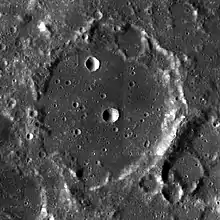Babcock (crater)
Babcock is a lunar impact crater that is located on the far side of the Moon. It was named after American astronomer Harold D. Babcock.[1] It lies on the northeastern edge of Mare Smythii, to the southeast of Mare Marginis. To the south of Babcock is the crater Purkynĕ, and to the east-northeast lies Erro. Babcock is located in a region of the Moon's surface that is occasionally brought into view during favorable librations, although it is seen from the edge and so little detail can be discerned from an observer on the Earth.

 Apollo 16 Mapping Camera image | |
| Coordinates | 4.2°N 93.9°E |
|---|---|
| Diameter | 99 km |
| Depth | Unknown |
| Colongitude | 267° at sunrise |
| Eponym | Harold D. Babcock |

The rim of Babcock has been eroded, notched and modified by subsequent impacts, leaving a somewhat irregular and uneven outer rim. The interior has been resurfaced by lava flows, and is relatively flat. In place of a central peak, a small crater lies very close to the crater midpoint. This crater has been designated Zasyadko. A smaller crater lies on the interior near the northern edge.
The area about Babcock has been subject to past inundations by basaltic lava flows, leaving the surface relatively flat and the remnants of ghost craters visible as curved ridges in the ground.
Satellite craters
By convention these features are identified on lunar maps by placing the letter on the side of the crater midpoint that is closest to Babcock.
| Babcock | Latitude | Longitude | Diameter |
|---|---|---|---|
| H | 3.0° N | 96.5° E | 63 km |
| K | 1.2° N | 95.2° E | 10 km |
References
- "Babcock (crater)". Gazetteer of Planetary Nomenclature. USGS Astrogeology Research Program.
- Andersson, L. E.; Whitaker, E. A. (1982). NASA Catalogue of Lunar Nomenclature. NASA RP-1097.
- Bussey, B.; Spudis, P. (2004). The Clementine Atlas of the Moon. New York: Cambridge University Press. ISBN 978-0-521-81528-4.
- Cocks, Elijah E.; Cocks, Josiah C. (1995). Who's Who on the Moon: A Biographical Dictionary of Lunar Nomenclature. Tudor Publishers. ISBN 978-0-936389-27-1.
- McDowell, Jonathan (July 15, 2007). "Lunar Nomenclature". Jonathan's Space Report. Retrieved 2007-10-24.
- Menzel, D. H.; Minnaert, M.; Levin, B.; Dollfus, A.; Bell, B. (1971). "Report on Lunar Nomenclature by the Working Group of Commission 17 of the IAU". Space Science Reviews. 12 (2): 136–186. Bibcode:1971SSRv...12..136M. doi:10.1007/BF00171763.
- Moore, Patrick (2001). On the Moon. Sterling Publishing Co. ISBN 978-0-304-35469-6.
- Price, Fred W. (1988). The Moon Observer's Handbook. Cambridge University Press. ISBN 978-0-521-33500-3.
- Rükl, Antonín (1990). Atlas of the Moon. Kalmbach Books. ISBN 978-0-913135-17-4.
- Webb, Rev. T. W. (1962). Celestial Objects for Common Telescopes (6th revised ed.). Dover. ISBN 978-0-486-20917-3.
- Whitaker, Ewen A. (1999). Mapping and Naming the Moon. Cambridge University Press. ISBN 978-0-521-62248-6.
- Wlasuk, Peter T. (2000). Observing the Moon. Springer. ISBN 978-1-85233-193-1.
